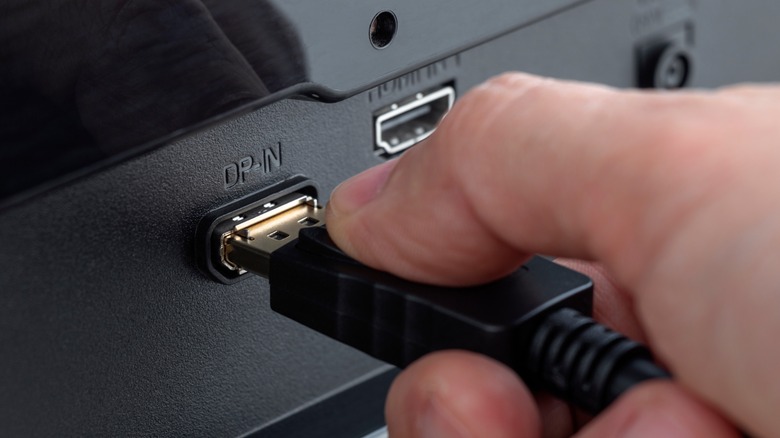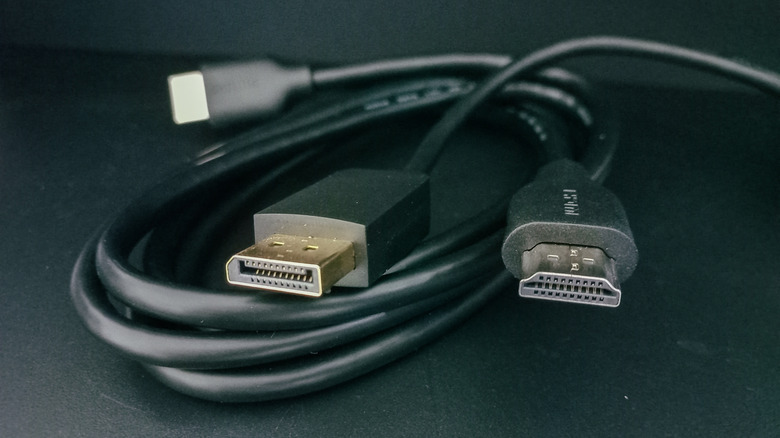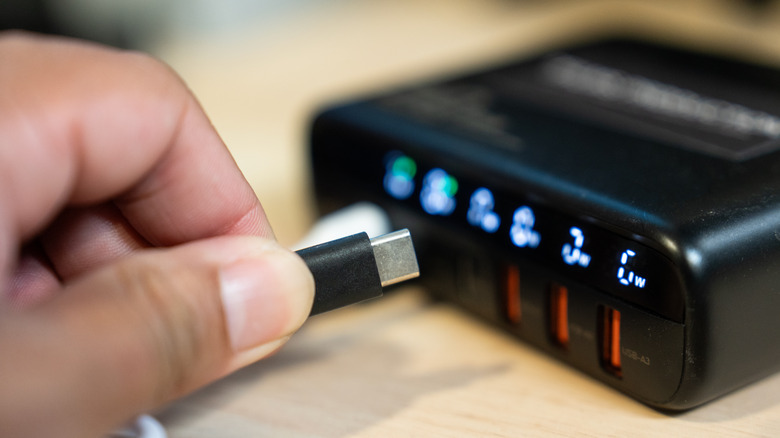Does DisplayPort Transmit Audio? What You Need To Know About The Interface
For-profit corporations working together and reaching a consensus on something that doesn't involve exploiting consumers is a rare sight. But consumer electronics standards such as Wi-Fi, USB, and HDMI are real examples of corporate cooperation that doesn't set off alarm bells at the FTC. It's easy to overlook the critical role of these hardware standards until you lose a laptop charger that isn't of the newer USB Type-C variety. While using the wrong laptop charger can potentially start a house fire, given how manufacturers won't even agree on the polarity of the charger's connectors, the display connectivity standards are fortunately well regulated.
HDMI and DisplayPort are the two competing video interfaces found on virtually all consumer gadgets incorporating a digital display. These digital audio/video connectivity standards allow billions of devices to hook up to TVs, computer monitors, and projectors over deceptively simple looking cables capable of transmitting not just video, but also audio, Ethernet data, and assorted control signals.
If you have come here wondering if the DisplayPort cable on your computer monitor can relay audio to your desktop speakers like HDMI does in your living room TV, the short answer is yes. DisplayPort and HDMI have a near feature parity for most important features, and carrying digital audio is indeed supported by both interfaces. However, you should consider reading on to learn more about the DisplayPort standard, and especially if you aren't certain whether you should choose it over HDMI for your specific hardware setup and needs.
DisplayPort or HDMI, what's ideal for serious audio applications?
Because the HDMI interface is considered the standard for televisions and home theater systems, one would assume that it has an edge in audio delivery over DisplayPort, which is otherwise optimized for high refresh rate computer displays. However, even the relatively older HDMI 2.0 and DisplayPort 1.4 standards support an eye-watering 32 audio channels at per-channel sampling rates and size of 192KHz and 24-bits, respectively.
To put this into perspective, a typical 2.1 speaker and subwoofer setup only consumes three channels, whereas even a 7.1 home theater setup amounts to eight channels. While DisplayPort can support every multi-channel home theater audio format under the sun on paper, good luck finding televisions, projectors, Blu-ray players, home theater receivers, and video game consoles compatible with the interface. There really isn't a practical way to harness DisplayPort's impressive audio potential because it's unsupported by the home theater ecosystem.
DisplayPort also lacks important audio-specific features inherent to the HDMI standard. The support for eARC protocol is one such feature that allows your TV to route audio signals from connected devices, such as Blu-ray players and video game consoles, to sound bars and AV receivers. This audio return channel implementation bypasses poor-quality, in-built television speakers and relays DTS and Dolby Digital audio streams to more capable external audio setups.
Other gaming console specific features such as Auto Low Latency Mode (ALLM), which automatically switches your TV to the gaming mode, are also absent on DisplayPort. But that's also because DisplayPort doesn't suffer from latency issues.
USB-C Alt Modes: Running HDMI and DisplayPort over one cable
The choice between DisplayPort and HDMI seems pretty clear then. The former's massive 80Gbps bandwidth capability makes it suitable for workstation, productivity, and PC gaming applications where high resolution and variable refresh rates are preferred. And HDMI is the de facto standard for home theater and console gaming thanks to its wide compatibility and native support for multichannel audio.
Unfortunately, there's no such thing as a clear choice in the consumer electronics world. In fact, you don't need DisplayPort connectors on your devices, or even a DisplayPort cable between them, to use the standard and all of its features with devices released after 2018. That's because most modern PCs, laptops, tablets, and smartphones bearing USB Type-C ports support both HDMI and DisplayPort Alt Modes capable of hosting both display protocols over the same USB-C cable.
This includes running DisplayPort and HDMI displays beyond video resolution of 5K and more, while also carrying all the audio, Ethernet, and other control signals over the same cable alongside a maximum of 240 watts of power thanks to USB PD. In fact, the same USB-C cable carries all HDMI or DisplayPort data in addition to USB data and power signals, which is great for portable devices such as laptops and tablets to do everything without a rat's nest of cables to handle display, audio, Ethernet, and power delivery. If you're running the relatively new laptop attached to an equally recent docking station, you might want to look into running DisplayPort over USB-C to simplify your life.


